Roy June P51 Pilot
Flying P-51s out of Iwo Jima
Escorting B-29s to Japan
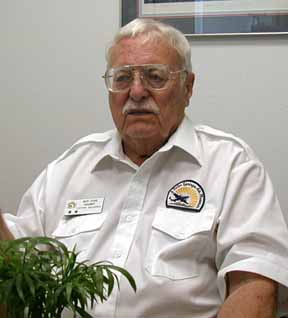
Webmaster: How did you get into the service in the first place?
I was at the University of Montana in Missoula in the first quarter of my sophomore year. This was 1943.
Webmaster: That would make you 18 or 19?
Yes, and my draft number was coming up. So a bunch of us at the fraternity were talking about this over a few beers and someone said let's all join the Air Force and be pilots. So the closest recruiting station was in Butte which was a little over 100 miles away. The next morning we all piled into two cars and drove to this recruiting station and told them we all wanted to be pilots. The sergeant gave us all a written test to become pilots. The test took an hour and we all passed it. Then a doctor there gave each of us a flight physical and I was the only one that passed. The sergeant said, "Do you want to join the Air Force?" I said, "Yes." He said step forward and raise your right hand and take the oath. I did and he said, "Welcome to the Air Force Private June."
The other guys were quite disappointed and we all went home. They did not have training openings for me at the time and I was told to go home and wait--that it would be about three months. I went home and finished that school quarter. I didn't start the next quarter but took odd jobs until notified to report. When the call came, I was ordered to report to Butte and took a train to Salt Lake to Santa Ana Army Air Base with a number of other cadets picked up along the way.
We spent about three months at Santa Ana which was classroom pre flight, physical training and more physical and eye exams and shots. A lot of the cadets were washed out of the flight program.
All the primary flight schools were operated privately. Ryan schools used the Ryan Recruit PT-22 primary trainer and the instructor was a civilian instructor. Primary lasted about two months. You had to fly 8 hours dual prior to solo. By the time you finished primary, you probably had 60 flight hours. Part of each day was devoted to school on engines, weather, navigation, etc. along with flight training. More cadets were washed out in this phase of training.
The next level of training was basic which was with the army at Lemore Field south of Fresno. You now encountered military discipline in flying with this new army instructor. We flew the Vultee BT-13 and BT-15 which were the same basic trainers except for a different engine. We flew half a day and spent the balance in class and physical training. Near the end of basic training, we flew several legs of a cross country flight.
The final phase of training was Advance Training at Williams Field near Chandler, Arizona. There I flew AT6 Texans. The routing was the same, school and flying and night cross country training. After graduation, I got my wings and commission as 2nd Lieutenant. Up to that time, I was a buck private. We got ten days leave and were then assigned to an overseas replacement unit in Blacksburg, Virginia flying P-47s.
When I reported in, I showed up at the ready room and the colonel in charge asked me what I was there for. I said I was there to check out in a P-47. He told me to go sit in the cockpit for a couple of hours until I had completely memorized the location of all the controls and instruments. Then have the crew chief blindfold you and give you an exam on what you have learned.
I took the test and passed and returned to the colonel and informed him of my success. He said, "Well, you're a pilot. What are you waiting for? Go out and fly the airplane."
I said, "Sir, is there a pilots manual here that I can look at to see some of the characteristics of this airplane?"
He answered, "Oh there is one around here someplace but I don't know where it is. I don't think you will need it."
I was 21 years old with a white scarf attitude so I got in the airplane and took off. I immediately realized is was a lot heavier airplane than the AT6 and a lot heavier on the controls but I adjusted. Our training consisted of gunnery and low altitude passes in addition to firing on targets towed behind a B-17. A lot of schooling was on European winter flying and we were issued winter flight clothing and we studied maps of Europe. When we were all done, the Commanding Officer lined us up and said, "Everybody from A to I line up over there and from J to Z over here. You guys [pointing to the A-I group] are going to Europe and the others are going to the Pacific." I said to myself, "Why the hell the Pacific." So they sent us by train from Virginia to Fort Lewis. We were in Fort Lewis for a week and never saw the sun. It rained all the time.
They put us on a ship to Hawaii--an eight day trip. I was attached to the 47th Fighter Squadron and flew P-47s there in training. This was the summer and fall of 1944. We did formation flying somewhat like the Blue Angels do now. The purpose was to teach the Wingmen to fly with their Flight and Element Leaders. The defensive and offensive tactics were all four ship flights. You almost always flew with the same pilots so you became a team.
Webmaster: How many hours did you have by that time in the P-47?
From 350-400 hours in the P-47. I was so used to that P-47, I could wear it like a glove. However in February of 1945 we were switched into P-51s of which I had only four hours flying time then sent to Saipan at the time the Marines were taking Iwo Jima.
When the United States Marines invaded the island of Iwo Jima on February 19, 1945, their intent among others was to establish an airbase for P-51D fighters. Fighters that would be in a position to escort our B-29 Bombers based on Saipan and Tinian to targets on the Japanese mainland. The island was also to be a base for B-29's low on fuel, damaged or with wounded crew who couldn't make it back to the Marianas. After the island was sufficiently secured to allow the construction of runways, these escort flights commenced in early April of 1945. Prior to these escorts, our B-29 casualties were high from land based Japanese fighters.
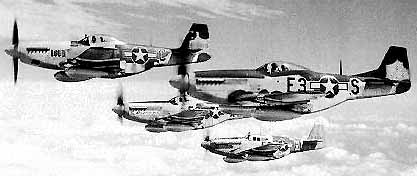
In March of 1945, we held 1/3 of Iwo Jima which included the Japanese airfield and about 20 yards. As soon as the Seabees could get in and patch up the airfield, we flew our P-51s to Iwo Jima while the fighting for the rest of the island was still underway. The Japanese were firing their mortars out of caves knocking holes in the airstrip keeping the Seabees busy patching it up while under fire. Our first landing on that runway was the bumpiest, rottenest runway I had ever encountered. We parked our airplanes and tried to create a bivouac area in pea-sized volcanic ash. For a week, we took off downwind because it was too dangerous the other way because of the Japanese. The Marine Commander asked us to give him ground support while they were taking the rest of the island which we did.
Iwo Jima is two miles wide and three miles long and eventually had three runways. When the island was finally secured, it was time for us to start the runs to Tokyo escorting our B-29s coming out of the Marianas. We loaded up the 51s with 110 gallons in each external wing tank, 92 gallons in the internal tanks and we had an 85 gallon tank behind the pilot. With that load of fuel and full gun bays for six machine guns between 460-480 rounds for each gun, we "flubbed" the 51 into the air to begin our mission. With that load of fuel, we could stay up for 8 hours and most of the missions ran that long. This allowed you about 20 minutes over Japan and then we had to find our B-29 escort back to Iwo. We did not have navigation aids and depended upon the 29s to get us back to that speck in the Pacific Ocean.
We had submarines about 35 miles off shore to pick up any downed pilots. Eleven of our pilots bailed out over the submarines and all were rescued.
Webmaster: Do you happen to remember the names of some of those submarines?
Yes, USS Tigrone, USS Trutta, USS Trepang, USS Pipefish and the USS Scabbardfish. I think these submarines were named officially, the "Lifeguard League." On one occasion the Destroyer Escort D.E. Brough was involved in picking up a downed P-51 pilot. There were also supposed to be ships between Iwo and Tokyo but I never saw any.
Webmaster: That 20 minutes over Japan consisted of what?
It kind of depended--early on the Japanese fighters came up after the B-29s but after awhile they started to disappear in the air. It was not because they were chicken, they were saving and hiding them away from the cities for use when we invaded the mainland. By doing so, they were also saving pilots and fuel. So if there were no fighter threat to our B-29s then we looked for targets of opportunity on the ground.
Webmaster: On August 15, 1945 when it was announced that the war was over, how many missions had you flown at that point, how did you hear about the end of the war and where were you?
I had 11 missions over Japan and 17 all told. Part of them were in the Bonin Islands consisting of attacks on these other islands.
Webmaster: That is what George Bush did--attack one of those Bonin Islands--Chi Chi Jima.
Yes, they had radios on those islands and would inform the homeland when the B-29s were coming. So periodically we went over and strafed the hell out of them and dropped 500 pound bombs. That is where I did my first skip bombing. We would approach the island low over the water and drop the bombs hoping they would skip up and over the coastal embankment into the Japanese camps and radio installations. However it didn't work that way and my bombs bounced straight up into the air above us so that was the end of the skip bombing program. After that we strafed and dive bombed those installations. When the war was over, I had over 500 combat hours in the 51.
Webmaster: You were on Iwo Jima when the war ended?
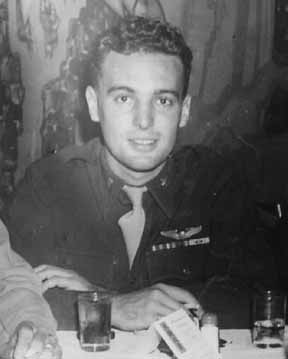
Yes, the way I found out is that one of the guys had just returned from Honolulu and he brought with him the Honolulu Daily Advertiser. Big headlines, "Atomic Bomb Dropped On Japan." We had no idea what that was. I flew my last mission several days after the second bomb was dropped. My squadron was assigned to go to Japan and become part of the army of occupation but I had enough time in I was released to return to the US and home. I island hopped in a C-47 from Iwo to Saipan to Guam to Johnson Island to Kwajalein to Hawaii. It took us two days to get to Hawaii. It was difficult getting from Hawaii to home because of the heavy demand and I got bounced by higher ranks. After about 10 days, I got on a C-54 to Hamilton Field near San Francisco. It was a war weary plane and we lost an engine on the way. The pilot got on the intercom and announced, "Well all you souvenir hunters that have all those valuable souvenirs in your barracks bag and you B4 bag, get ready to throw them overboard because we probably are going to have to lighten up the aircraft." As it turned out, we didn't have to throw anything overboard and got to Hamilton Field OK.
I got 30 days leave at home in Missoula and had to return to Santa Ana to process out. I got back home to Missoula just in time to start a new quarter.
Webmaster: What was your rank at this time?
I was a first lieutenant. Out unit was stingy with rank. Out CO was a captain and our flight and element leaders were first lieutenants--wingmen were second lieutenants.
Webmaster: Backing up to those missions out of Iwo, didn't you run into severe weather on one of them and lose some pilots?
Yes, we lost a lot of pilots to weather that day.
Webmaster: Tell me about it.
June 1, 1945 seemed like any ordinary day. I rose with the sun, showered, shaved and brushed my teeth--all with salt water. Of course when you live on a 2 mile by 5 mile island far into the Pacific Ocean, there is not a lot of fresh water available. There was no natural water source on Iwo and all water had to be shipped in. Iwo Jima, Japanese since 1891, is one of several small islands making up the Volcano Islands chain and is approximately 900 miles due south of Tokyo known as the Bonins.
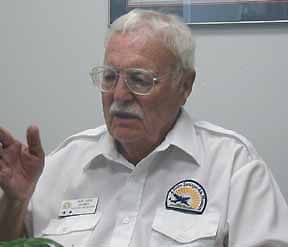
With that in mind, it still seemed like an ordinary day. As usual, a mission had been scheduled. The bulletin board indicated that they were to escort the Superforts on an incendiary raid to Osaka. If conditions were bad on Iwo Jima they were going to be a lot worse in Osaka by this afternoon.
Three squadrons from the 15th Fighter Group, the 45th, the 47th and the 78th were assigned as well as other groups. I as element leader Blue Flight for the 47th Fighter Group with wingman, Lt. Joe Wagner. 148 Mustangs would fly to Osaka today. 148 men crammed into a space not much larger than a school locker for seven plus hours. Of those who returned, many would have to be lifted out of the cockpit because of the inability of our cramped muscles to lift their body weight.
Breakfast consisted of powdered eggs, powdered milk, Spam and dehydrated potatoes. No coffee or liquids of any kind. Not when you plan on spending most of your day 30,000 feet above and miles away from the nearest latrine. Yes, the P-51 does have a relief tube but if used, the ground crew has to clean it up. It's better just to wait until return to have coffee. This is all just talk though, most pilots seldom eat prior to a mission. They probably couldn't hold it down anyway.
The mission briefing indicated some weather reported between Iwo and Japan. The mission was a "high priority" mission, of course they all were. No one ever recalled them advising that "this is not an important mission." The duration of the flight would be seven hours and forty-five minutes. My muscles started to cramp already just at the thought.
On the flight line, "number 152 is ready," Crew Chief, Sgt. Steffy informed me. The exterior drop tanks were in place, parachute and inflatable life raft in the cockpit and the seat pack was tied to the chute. No need to lose it in the water. I knew it wasn't necessary to check any further. I did not have the time and I trusted Sgt. Steffy with my life.
The Rolls Royce Merlin fired up and hummed reassuringly. Takeoff was routine. I joined up with the red, yellow and green flights of the 47th. We picked up a heading for mainland Japan and Osaka. Other groups nearby were on the same heading.
250 miles out and the weather started to deteriorate. By 375 miles out we were in it. Visibility was zero. Inside the cockpit, it is darker than midnight. I can't see the flight leader. I can't see my wingman. We were in a tight formation going into the weather front so there is a danger of collision. I flipped on my cockpit light. It is raining heavily now and my canopy is leaking. Old 152 is being battered by violent turbulence. Rain is getting worse and the altimeter is spinning like a drunken dervish. Updrafts and downdrafts are bucking this Mustang first up 3000 feet and then down 3000 feet. This Mustang is a bucking bronco.
I'm alone. Where is my flight leader? I can't see my wingman. I'm lost! I drop the seat for better view of the instruments and begin serious instrument flying. My eyes sweep the altimeter, directional gyro, airspeed indicator, needle ball and rate of climb. I let the altimeter and rate of climb take care of themselves. They are uncontrollable in this weather.
Through the static on the radio, I hear frantic calls for position then silence except for the noise of the storm. After a short time, I broke out into a clear area but I'm surrounded by weather. It's like being in the hole of a doughnut--the eye of a typhoon! It's twenty miles across. I climbed up to 48,000 feet hoping to go over the top but the top appears to be another 35,000 feet above me. Far too high for a P-51 so I drop down to the ocean but no room to go under it. I can hear group leaders trying to gather up their squadrons. Planes are scattered all over hell.
I'm way off course now with no idea where I am. There are no other Mustangs in sight. The radio blasts, "May Day! May Day! I'm bailing out!" I hear it again but another voice and then another voice then silence. Then, "Hit another plane, bailing out!" Now silence.
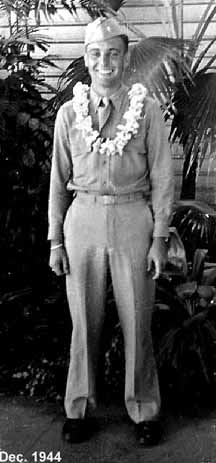
A group commander shouts, "Mission abort! Mission abort!" OK, but where am I--blown off course I'm sure? I've been out three hours. What is my heading to Iwo? The original heading is no good and I have weather between me and Iwo. Iwo, that little dot in the Pacific with no ground reference points. The P-51 has no navigation facilities other than a radio with a range of 30 miles. We depend upon the B-29s for navigation. Without the B-29s, we are lost. My only option is to fly a compass heading and ETA toward where I think Iwo is then search in a wider and wider area until I run out of fuel. Bail out, climb into the life raft, dump sea dye and hope. Of course I could pick up a heading for Japan and bail out. They do not treat pilots well. That is not an option. I take my only option, dive back into the front, go on instruments and hope.
It's again black as midnight. The altimeter is spinning and the Mustang is again trying to throw me out of the cockpit. The canopy is leaking worse than before. I would swear that I'm in a tight descending right turn but my instruments tell me I'm flying straight. I must have vertigo induced by the turbulence. I believe my instruments and fight off the inclination to pull out of the turn. The radio comes to life with frantic calls for position. "May Day! May Day!"
I finally bounced out of the soup into a clear area. My vertigo disappeared. Is that a B-29 in the distance? Yes, it was not an illusion. I approached then remembered to show the B-29 gunners a good silhouette, top, bottom, side of the P-51. They need to know I am a friendly Mustang. I moved in closely and tried for radio contact--no response. With hand signals, I asked for Iwo heading--still no response. I held my position next to them.
Now there was more weather ahead. I moved in closer to the B-29. More rain pummeled through the leaky canopy. The violent turbulence returned and the vertigo returned. I watched my instruments and resisted the inclination to correct. We broke out into the clear again and my vertigo disappeared. I hugged the B-29 as time passed.
Suddenly Iwo is in sight. The B-29 had altered course to go by Iwo. I racked my wings violently in thanks as I dropped away to the landing field. I had been out five hours and Sgt. Steffy had a sign of relief on his face when I opened the canopy. At debriefing the bad news hit. The 47th lost five of its 20 pilots and planes to weather. The mission total loss was 27 pilots and planes to weather.
I was shocked and angry. Why such poor weather reports? How could they miss it this far? Who ordered this mission? Who prepared the weather information? The investigation began and General Hap Arnold visits Iwo to get answers to those questions. The top brass hold meetings, reports are written, findings are nil--no real conclusions come forth. It is declared that the weather developed too fast to comprehend its magnitude.
I arrived safe back on Iwo to fly again to Japan--not so for five of my fellow pilots, Lt. Jennings, Lt. Dibelka, Lt. Schroeder, Lt. Frick and Lt. Van Zandt--all lost on this June 1 mission. Also twenty-two other pilots from other squadrons.
Webmaster: Thank you Roy for your time and your service to our country.
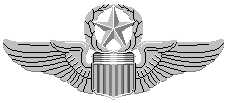

|